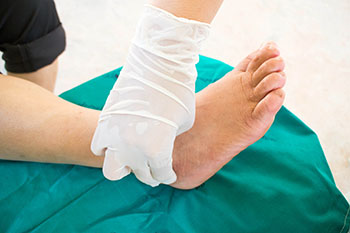Foot & Ankle Wound Care in Thousand Oaks, CA

Wound care is particularly important for those with diabetes. It’s possible that what appears to be a small wound could turn into more severe foot complications down the road if left untreated. It’s common for those with diabetes to experience neuropathy. Neuropathy is a type of nerve damage that affects the body and can cause you to lose feeling in the feet. If you’re no longer experiencing feeling in your feet and a wound develops, it’s very possible it may go unnoticed if you don’t check your feet daily.
Causes of Diabetic Wounds
Some factors that contribute to the formation of wounds on the feet include wearing tightly fitted shoes, getting a pebble stuck in your shoe, or simply walking. What may appear to be just a small inconvenience such as a blister or callus can worsen over time, so it’s important to be safe and seek the attention of a professional. If you’ve developed a wound, it’s recommended that you try your best to keep the weight off of the area until you’re able to meet with a podiatrist.
Wounds should be taken care of immediately after discovery, as even the smallest of wounds can become infected if enough bacteria build up within the wound. To remove dirt, wounds should first be rinsed under running water only. Soap, hydrogen peroxide, or iodine can irritate the injury and should be avoided. To prevent infection, apply antibiotic ointment to the wound and cover it with a bandage. The bandage should be changed daily. The skin around the wound may be cleaned with soap.
Wound Prevention
In order to prevent these worst-case scenarios from occurring, people with diabetes should do everything they can to avoid wounds from developing in the first place. Managing their diabetes is essential. Keeping glucose levels under control can help reduce the risk of developing a wound.
Other ways to prevent wounds from developing include checking your feet daily for any injuries, washing and drying your feet daily, dressing for comfort and making sure your toes have enough space, and properly trimming your toenails straight across. You should also examine every part of your foot: the top of the feet, the bottom of the feet, the sides, the toenails, and in between the toes. A mirror can be used to aid in this daily inspection, if necessary. Things to look for include cuts, blisters, bruises, calluses, corns, sores, cracked skin, redness, bumps, lumps, ingrown toenails, puffy skin, tenderness, pain, or differences in temperature. Anything out of the ordinary should be reported to a podiatrist immediately.
Diabetic Foot Wounds
Diabetes affects more than 29 million people in the United States. Non-healing diabetic foot wounds result in five out of every six amputations. We take pride in our advanced and personalized diabetic wound care and limb salvage program. We offer the very latest medical and surgical treatment options for our diabetic wound care patients. In addition to treatment of current diabetic wounds, we also participate in the Medicare Therapeutic shoe program to supply diabetics with a pair of shoes and three protective inserts per year.
Venous and Arterial Wounds
Vascular leg wounds are debilitating and greatly impact daily activities reducing quality of life. Healing your leg wounds and getting you moving again is our number one priority.
Acute and Traumatic Wounds
Because of the severity of traumatic wounds and their vast range of etiologies, treatment can either be as simple as cleaning and dressing the wound, or it can be more extensive and require surgical intervention to close the wound and stabilize the patient. The treatment of traumatic wounds involves repairing damage to the body’s underlying tissue structures, removing any foreign particles and allowing for drainage of the wounds. All of these steps are essential to prevent the possibility of infection and to promote healing.
When Diabetic Wounds Don’t Heal
Wounds in a person with diabetes can be dangerous. A diabetic wound can heal slowly, not heal properly, or in some cases, never heal, making it an ulcer. Ulcers that are not healed promptly and properly have the potential of becoming infected and, sometimes, this infection may even spread to nearby tissue and bone, which is a serious health issue. An infection, and/or lack of blood flow can cause tissue to die, which is known as gangrene. Dead tissue must be surgically removed to prevent bacteria from entering and spreading through the bloodstream. This procedure is known as debridement. Early detection and intervention are extremely important in mitigating the risk to healthy tissue, and to prevent an amputation from becoming necessary.
Because wounds can lead to more severe complications, especially for those with diabetes, we recommend you speak with a podiatrist for professional guidance and a suggested plan for treatment.
